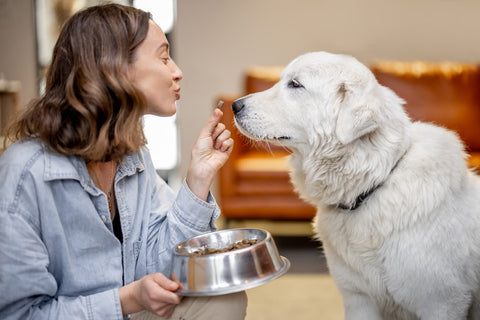Did you know hair loss can affect up to half of all dogs?¹ If your pup is losing hair, don't worry. There are plenty of ways you can help support their skin, coat, and overall health.
Key Takeaways
- Hair loss can be caused by a wide range of factors.
- In some cases, hair loss is natural, and certain breeds are more likely to experience it.
- However, hair loss can also be a sign that your dog is stressed, coming into contact with allergens, or not getting enough nutrients.
- Supplements like CBD can help promote relaxation and soothe skin-related issues associated with seasonal allergies.
- These supplements may also contain ingredients like essential fatty acids that help promote healthy skin and coat.
See Related: What to Do When Your Dog Has a Loss of Appetite
Understanding Hair Loss in Dogs
A sudden loss of hair can be concerning for anyone. In dogs, hair loss can be caused by a wide range of factors.
Sometimes, hair loss in dogs is nothing to worry about. For example, many different breeds of dogs shed. In one survey by a vet, almost half of respondents reported their dogs shed at least a "moderate" amount of hair.²
Some dogs may also be genetically inclined to hair loss. For example, one study found changes in a single gene, SGK3, caused Scottish Deerhound puppies to lose all of their hair within a few weeks of being born.³
Other studies have established links between other genes and various features of a dog's coat, including curliness, coarseness, and more.⁴
Breeds Susceptible to Hair Loss
Genetic differences mean some breeds of dog are more susceptible to hair loss. According to one 2017 study, Dachshunds are the breed most likely to develop pattern baldness.⁵ Hair loss for these dogs most often starts on the ears, and as time goes on can spread to other areas.⁶
Several breeds are more likely than others to lose hair along the flank, including Boxers, Bulldogs, and Miniature Schnauzers.⁷
And longer-haired dogs may shed more often than their shorter-haired cousins.⁸
Bonus: Anandamide: What Are the Benefits of This Cannabinoid?

Bald Spots or Bald Patches
Generally, dogs will experience patchy hair loss, rather than complete baldness. Bald spots might start out small, but can spread to other areas if the underlying cause is not addressed.
Checking Your Dog's Skin
It's best to address hair loss as soon as possible. That's why it's important to keep an eye on your dog's skin and coat. If you brush or bathe your pup, consider using that as an opportunity to check for any unusual hair loss.
Supporting Your Dog's Coat
There are plenty of ways to support your dog's skin and coat, whether they have hair loss or not. For example, hemp extract with CBD contains essential fatty acids that are essential for a healthy skin and coat. Similarly, our Maxx Life Glutathione is rich in antioxidants, which can help your dog maintain a soft, silky, shiny, and healthy coat.
We'll cover more methods in relation to the specific causes of hair loss that they may help address.
Dog Hair Loss: Common Causes & Tips to Help
As we mentioned above, hair loss can have many causes. Before we investigate a few common causes, it's important to reiterate that seasonal shedding is entirely normal.
Excessive shedding, however, may be a sign that something is wrong. Other common symptoms of hair loss to look out for include the following:
- Thinning hair
- Pigmented skin
- Redness
- Dry skin
These symptoms often accompany unwanted hair loss. To reduce unwanted hair loss, we first need to determine what, exactly, is causing that hair loss.

Stress
Hair and stress are interconnected. We humans are so attuned to this connection that we joke about our hair turning gray or falling out altogether as a result of stress.
This connection between hair and stress is also present in dogs. The stress hormone cortisol is deposited in hair, which makes hair a useful tool to measure how a dog's stress levels change over time.
In one study, an analysis of hair found that cortisol levels increased by almost one-third when dogs were in a stressful situation (in this case, a shelter).⁹
Another study found that stress was associated with premature greying in dogs.¹⁰ Stress can also cause increased hair loss.¹¹
In some cases, it's not the stress itself that causes hair loss, but the behaviors that stress causes. Dogs who are stressed may exhibit certain behaviors, such as excessive grooming or licking.¹² In turn, these behaviors can cause hair loss.
If you think your dog is stressed, the best thing to do is eliminate the cause of their stress. Unfortunately, that's not always possible. Your dog might dislike going in the car, for example, but sometimes you may have no other option.
Fortunately, there are plenty of ways to help your dog manage stress. Multiple studies have demonstrated that cannabidiol, or CBD, can promote relaxation in dogs.¹³ Your dog may love our calming hemp dog treats, which contain whole plant extract and come in multiple delicious flavors.
Alternatively, consider our Balance CBD & CBDa Extract, which combines CBD with CBDa to help your pup cope with external stresses. Our Quick Calm spray also helps dogs manage normal stress, and is easy to apply when needed.
Allergies
Various allergies can cause dogs to lose hair. Food allergies, allergies to certain ingredients in things like cleaners, and environmental allergies to things like pollen and dust can all cause hair loss.
Allergies often cause itchy skin. Dogs may excessively lick, scratch, and bite at their itchy skin, which can cause a loss of hair.¹⁴
If your pup is dealing with seasonal allergies, we recommend using our Gut Health Supplement or our Immunity Mushroom Supplement, which are some of our top-selling allergy products. You can pair them with our Paw & Skin Balm, too. This skin product combines whole plant hemp extract, organic coconut oil, mango butter, and beeswax to create a topical balm that helps soothe skin-related issues associated with seasonal allergies.

Nutritional Causes
Your dog's hair loss may also be caused by a nutrient deficiency. Perhaps they are allergic to something in their food, or their diet isn't giving them everything they need to be fully healthy.¹⁵
Nutrient deficiencies can also be caused by various health conditions. If you're unsure, check with your vet. They'll be able to help you get to the bottom of the issue.
Aging
When dogs age, their hair may change.¹⁶ It may go grey, as we discussed above. The quality of the hair, such as its thickness, may also change.¹⁷
In some cases, aging may also come with hair thinning or even hair loss. This is especially true for breeds predisposed to hair loss, like Dachshunds. ¹⁸
Insect Bites
All kinds of creepy crawlies love to hitch a ride on your dog. Their bites, and even their mere presence, can cause your dog to scratch, lick, and nibble their coat. In turn, that can cause hair loss.
Your dog may also be allergic to certain insects and/or their bites, which can also cause hair loss.¹⁹
Other Possible Causes
Various other factors can cause or contribute to hair loss. If the causes above don't seem to apply to your pup, or the tips we shared don't seem to help, consult your vet. They'll be able to help you support your furry friend's hair.

Conclusion
Seeing your dog lose their hair can be stressful. In some cases, a little hair loss is entirely normal.
But in other cases, hair loss can be a sign your dog needs some additional support. That support might come in the form of a supplement, like CBD. It might come from a change in diet or environment to reduce exposure to stresses and allergens.
And sometimes, hair loss requires the help of a vet.
Keep Reading: 10 Signs Your Dog Needs Probiotics
Sources
- Alopecia in dogs: Causes, Incidence and Clinical Signs with a Special Reference to Nutritional Alopecia
- Dog Shedding Explained - Embarkvet
- Study finds gene variant which causes hairlessness in dogs
- The bald and the beautiful: hairlessness in domestic dog breeds - PMC
- Alopecia Areata in a Dog: Clinical, Dermoscopic and Histological Features - PMC
- https://animalallergycolorado.com/animal-disease-index/pattern-baldness
- Alopecia in a Boxer in: Journal of the American Veterinary Medical Association Volume 262 Issue 12 (2024)
- Alopecia in dogs: Causes, Incidence and Clinical Signs with a Special Reference to Nutritional Alopecia
- Dog hair cortisol levels can tell us how stressful shelters are | New Scientist
- Anxiety and impulsivity: Factors associated with premature graying in young dogs - ScienceDirect
- How chronic stress leads to hair loss | Harvard Stem Cell Institute (HSCI)
- The Science Behind the Slurp: Why Dogs Engage in Excessive Licking
- Daily dosing of cannabidiol (CBD) demonstrates a positive effect on measures of stress in dogs during repeated exposure to car travel | Journal of Animal Science | Oxford Academic , New study shows cannabidiol (CBD) is effective at reducing stress in dogs | WALTHAM , A single dose of cannabidiol (CBD) positively influences measures of stress in dogs during separation and car travel - PMC
- Atopic dermatitis (atopy) | Cornell University College of Veterinary Medicine
- Nutritional deficiencies and hair loss in dogs - Vetster
- Ageing canine companions: Most common manifestations and the impact of selected factors - ScienceDirect
- The phenotype of aging in the dog: how aging impacts the health and well-being of dogs and their caregivers in
- Pattern Baldness
- Alopecia in the Dog - WSAVA2013 - VIN
–
Earth Buddy is an environmentally conscious and family-owned company dedicated to providing natural solutions for pets. From our CBD oils to our colostrum supplements, our products are designed to promote calmness and encourage relaxation for our furry friends. To learn more and stay connected, follow us on Facebook, Instagram, LinkedIn, YouTube, and Pinterest.






Comments (0)
There are no comments for this article. Be the first one to leave a message!